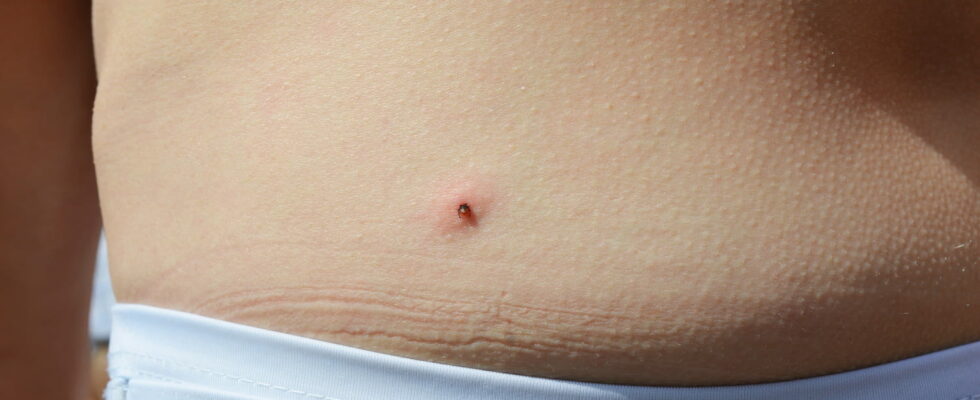The tick is potentially a carrier of Borrelia burgdorferi, a bacteria that causes Lyme disease.
In France, the risk of transmission of a tick-borne disease to humans is low (1 to 4%) but it does exist. To know if this bacteria has infected you, you must monitor a particular symptom.
As with any insect or mite bite, the skin may become red immediately at the site of the bite. “The area is red and itchy, this reaction is normal. These immediate symptoms are not alarming, even after a tick bite. Immediate redness is an inflammatory or allergic reaction to the tick’s saliva and not the first sign of Lyme disease. It will gradually disappear. There is no need to see your doctor; no preventive antibiotics are useful.” explains Dr Pauline Arias, infectious disease specialist at the CRMVT (Reference Centers for Tick-Borne Diseases) Île de France-Hauts de France.
On the other hand, the first and main symptom to appear in case of infection by the bacteria Borrelia burgdorferi is erythema migrans. “Erythema migrans is a redness that appears a few days after the bite, because the bacteria need time to proliferate and create the infection in the skin.explains Dr. Pauline Arias. This is why a tick bite must be monitored by the bitten subject. We cannot make a diagnosis immediately after the bite.” You should inspect yourself when you get home: “The tick likes warm, thin, moist skin. We look between the toes, in the hollows of the knees, at the navel, inguinal folds, external genitalia, armpits, scalp line and behind the ears.”
“It’s a bit like when we put red dye on white cloth: the stain spreads.”
The redness tends to spread and diffuse across the skin. “It’s a bit like when we put red dye on white linen: the stain spreads over the textile fibres, becoming lighter in the centre, illustrates the specialist. The spread is also progressive at the skin level, it lightens in the center and remains red on the periphery.” To check the extent of the redness, you can draw a line around the lesion with a felt-tip pen. “The most important thing is to see that it is growing: it can reach up to 30 cm.” Erythema migrans occurs at least 3 days and usually up to a month after the tick bite. Most often, the lesion is painless, it does not itch or sting. If these symptoms occur, they are mild sensations. They are not intense. Other signs sometimes accompany erythema migrans, such as fatigue or muscle and joint pain. Fever is not a characteristic symptom of this infectious disease. In case of fever after a tick bite, you should consider other diagnoses and consult your doctor.
“Without treatment, the redness can either disappear on its own within a few weeks or continue to develop into more complicated forms of Lyme disease (articular and neurological). Early antibiotic treatment can eradicate the infection. The redness diminishes rapidly with antibiotics and generally disappears completely within 2 or 3 weeks. Some symptoms such as fatigue may persist for a few weeks but will also improve within this same time frame.” specifies the infectiologist.
Thanks to Dr Pauline Arias, infectious disease specialist at the CRMVT (Reference Centers for Tick-Borne Diseases) Île de France-Hauts de France.
